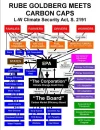palerider
Well-Known Member
- Joined
- Feb 26, 2007
- Messages
- 4,624
Since less sunlight reaches the surface when the atmosphere is more dense, one would expect the high mountains to be warmer than the lowlands as the atmosphere is less dense there.
One would only expect that if one didn't understand the ideal gas laws. Pressure creates heat....not the composition of the atmosphere.
, of course, you've uncovered scientific principles that have somehow escaped all of the scientific organizations in the world. Congratulations!
Of course I haven't. But what I have said is true. It is politically expedient to ignore the facts in favor of cherry picked hype....in case you aren't aware, the American Physical Society is reviewing their position on AGW....they have a panel of 6 (3 alarmists, 3 skeptics) who are going to review the facts....this time, unlike all the other times, the review is going to be done in public with the results being not only run by the membership but released to the public as well. The questions the alarmists on the panel will be asking are going to cause the APS to reverse its position on AGW. The APS is the biggest dog on the block in so far as scientific organizations go and if they chance their position, every other academy will be tripping over its feet to change as well. The days of the hoax are numbered.
Here are some of the questions that will be asked of the alarmists....perhaps you might like to answer one or two.
While the Global Mean Surface Temperature (GMST) rose strongly from 1980-98, it has shown no significant rise for the past 15 years…[The APS notes that neither the 4th nor 5th IPCC report modeling suggested any stasis would occur, and then asks] …
To what would you attribute the stasis?
If non-anthropogenic influences are strong enough to counteract the expected effects of increased CO2, why wouldn’t they be strong enough to sometimes enhance warming trends, and in so doing lead to an over-estimate of CO2 influence?
What are the implications of this stasis for confidence in the models and their projections?
What do you see as the likelihood of solar influences beyond TSI (total solar irradiance)? Is it coincidence that the statis has occurred during the weakest solar cycle (ie sunspot activity) in about a century?
Some have suggested that the ‘missing heat’ is going into the deep ocean…
Are deep ocean observations sufficient in coverage and precision to bear on this hypothesis quantitatively?
Why would the heat sequestration have ‘turned on’ at the turn of this century?
What could make it ‘turn off’ and when might that occur?
Is there any mechanism that would allow the added heat in the deep ocean to reappear in the atmosphere?
Climate Sensitivity
[This relates to the size of feedbacks to the agreed and mild CO2-induced warming. If feedbacks are powerful and positive, the alarmist case is strong. If feedbacks are weak or negative, there is no basis for any climate scare or for trillions of dollars to be spent on curbing CO2 emissions].
A factor-of-three uncertainty in the global surface temperature response to increasing atmospheric CO2 as expressed by equilibrium climate sensitivity, has persisted through the last three decades of research despite the significant intellectual effort that has been devoted to climate science.
What gives rise to the large uncertainties in this fundamental parameter of the climate system?
How is the IPCC’s expression of increasing confidence in the detection/attribution/projection of anthropogenic influences consistent with this persistent uncertainty?
Wouldn’t detection of an anthropogenic signal necessarily improve estimates of the response to anthropogenic perturbations?
Models and Projections
The APS notes that the IPCC draws on results and averages from large numbers of models, and comments, “In particular, it is not sufficient to demonstrate that some member of the ensemble [of models] gets it right at any given time. Rather, as in other fields of science, it is important to know how well the ‘best’ single model does at all times.”
Sea Ice
The APS notes that the models seem able to reproduce the Arctic declining ice trend, but not the Antarctic rising ice trend. Moreover, the APS has spotted that the IPCC had done its ice graphs using only 17 out of its 40 models, these 17 happening to produce reasonable fits with the data. The APS says,
“One may therefore conclude that the bulk of the CMIP5 [latest] models do not reproduce reasonable seasonal mean and magnitude of the ice cycle. Is that the case? And if so, what are the implications for the confidence with which the ensemble [the whole 40 models] can be used for other purposes?
Some of the other questions that will arise can be found here. A very uncomfortable time is ahead for those who have supported the hoax....maybe you should start looking for the nearest path to the tall grass yourself.

